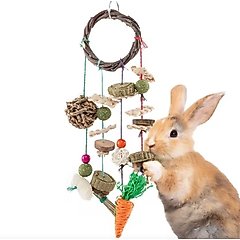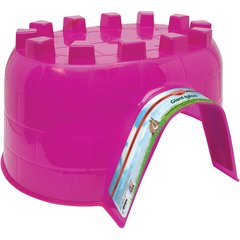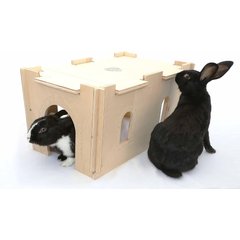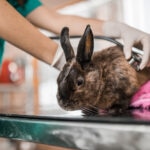Understanding Rabbit Body Language
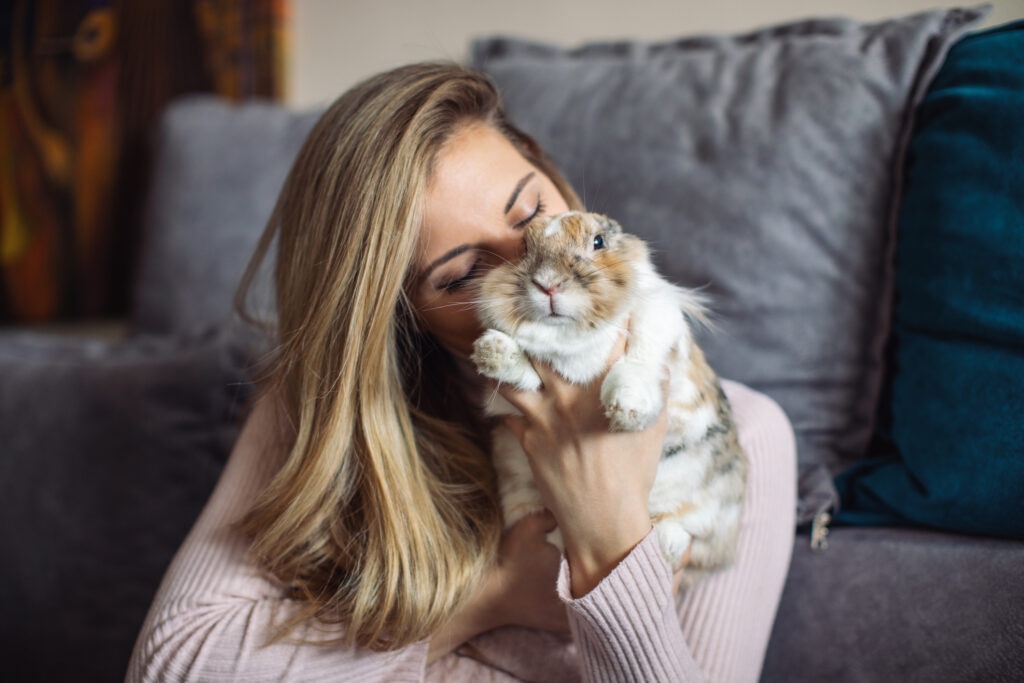
Photo by miljko/E+
Rabbits might not bark or meow, but that doesn’t mean they’re not communicating.
In fact, they’re constantly expressing themselves through bunny body language, which includes subtle shifts in posture, movement, and behavior.
Here’s what you need to know about rabbit body language, including how to decode common signals and respond in ways that help your bunny feel safe and understood.
Ears, Eyes, and Posture
When it comes to reading your rabbit, the ears, eyes, and body posture are some of the most reliable indicators of how they’re feeling. Let’s break it down.
Ears
“A rabbit’s ears can tell you a lot,” says Kristy Venrick-Mardon, founder of Only Sunshine Sanctuary, in Elverta, California. According to Venrick-Mardon, here’s what different ear positions mean:
- Upright and forward: Alert and curious; your bunny is interested in their surroundings.
- Laid back or to the sides: Relaxed and comfortable.
- Flattened tightly against the back: Scared, anxious, or angry; your bunny might feel threatened and is preparing to flee or defend themselves.
- Swiveling or twitching: Listening closely or unsure about something they’re hearing.
Eyes
It’s said that the eyes are the windows to the soul, and they can be very telling for rabbits. According to Venrick-Mardon, some common eye-related signals to watch for in bunnies include:
- Wide open eyes with an alert posture: Focused, curious, or excited; something has caught their attention.
- Wide eyes with a hunched or tense posture: Fear, stress, or discomfort; your bunny might feel threatened or unsafe.
- Soft, half-closed eyes: Relaxed, sleepy, or at ease.
Posture
Posture can reveal a lot about how a rabbit is feeling. According to Venrick-Mardon, here are a few common positions and what they typically mean:
- Loaf position (tucked in neatly like a bread loaf): Comfortable, relaxed, and safe.
- Pancake position (stretched out flat with head down): Very calm and relaxed.
- Flopped on their side: Deep relaxation and trust—this is bunny bliss!
- Crouched low with tense muscles: Fear or unease; your rabbit is on high alert.
Happy Bunny Behaviors
When your rabbit is feeling safe and happy, their body language becomes expressive (and downright adorable). Venrick-Mardon shares some classic signs of a happy bunny:
- Binkying: A “binky” is a sudden leap into the air, often with a twist or kick mid-jump. It’s one of the clearest signs your bunny is feeling playful and energized.
- Zoomies: When your rabbit races around the room or their enclosure at lightning speed, that’s a zoomie! This burst of energy is another sign your bunny is feeling safe, stimulated, and full of joy.
- Tooth purring: A gentle, rhythmic clicking of the teeth that often happens while being petted. It’s like a cat’s purr and signals contentment.
- Throwing toys around: This playful, curious behavior is a sure sign your bunny is in good spirits.
You can help encourage this kind of blissed-out bunny behavior with:
Recommended Products
- Healthy treats, such as Kaytee Baked Apple Timothy Biscuit Small Animal Treats and Science Selective Naturals Garden Sticks Rabbit Treats
Recommended Products
- Gentle pets (only on bunny-approved areas, of course!)
Signs of Stress, Fear, or Aggression in Bunnies
Just like happy bunnies have their own signature moves, so do anxious or frightened ones. Here’s what to look for:
- Thumping: When a rabbit forcefully thumps their back foot on the ground, it signals fear or frustration. It’s how they warn others that something feels wrong.
- Freezing in place or hiding: A bunny who suddenly goes rigid or bolts to their hideout is likely feeling scared or overwhelmed.
- Growling, lunging, or boxing: These behaviors are signs of fear-based aggression. Your rabbit might growl, lunge, or raise up and “box” with their front paws if they feel threatened or very stressed.
- Ears pinned back or tail raised: Flattened ears or a raised tail can be a subtle sign your bunny is feeling threatened and may be preparing to defend themselves.
- Teeth grinding (loud and strained): Unlike gentle tooth purring, loud teeth grinding may indicate pain or intense stress.
If you notice signs of stress or fear, it’s best to:
- Give them space: Step away from your bunny and allow them time to calm down.
- Use a quiet voice and slow movements: Sudden noises or gestures can escalate fear.
- Check for stressors: Look around for potential triggers, such as loud sounds, new animals, unfamiliar people, or changes in their environment.
- Offer hiding spots: Make sure your bunny has access to cozy hideaways, such as the Oxbow Timothy Club Tunnel Small Animal Hideout, the Kaytee Small Animal Igloo Hideout, or the Small Pet Select Habitat Hideout Tunnel.
Recommended Products
- Avoid punishment: Never scold or physically correct a fearful rabbit, as this can worsen the problem and damage trust.
- Build positive associations: After your bunny has had time to calm down, use a calming voice, soft petting (if they allow), and healthy treats to rebuild comfort and confidence.
Social Signals and Bonding
Rabbits are naturally social creatures who form strong bonds with trusted humans and fellow bunnies. But as prey animals, they’re instinctively cautious and slow to open up.
Once they feel safe, though, rabbits show their humans affection in subtle yet meaningful ways. You’ll often see the same behaviors between closely bonded bunny pairs.
Here are a few signs of connection to look for:
- Nudging you with their nose: A gentle nudge is your bunny’s way of saying, “Hey, notice me!” It could mean they want attention, pets, food, or just to check in.
- Light nipping: If a nose nudge doesn’t get your attention, a soft nip might follow. It’s usually not meant to hurt but to say, “Hurry up!”
- Grooming you: If your rabbit licks or softly nibbles you, they’re grooming you—a major sign of affection and trust.
- Bowing their head for pets: When a rabbit lowers their head toward you, they’re asking you to pet them. Respond with gentle forehead strokes to let them know the feeling is mutual.
- Flopping or lying near you: A bunny that stretches out or flops beside you feels safe and content in your presence.
- Following you around: If your rabbit follows you from room to room, you’re officially one of their favorite people. This behavior shows curiosity and a strong bond.
To encourage bonding, try the following:
- Let your rabbit set the pace: Don’t force interaction. Allow your bunny to approach you on their terms. Sit quietly nearby, avoid sudden movements, and be patient as they get used to your presence.
- Use calm, consistent interactions: Speak softly, move slowly, and offer gentle pets when welcomed. Over time, this approach builds trust and comfort.
- Offer positive reinforcement with toys and treats: Use toys and healthy snacks to reward relaxed, friendly behavior, whether it’s between you and your bunny or between two rabbits. This helps create positive associations with bonding time.
When To Be Concerned About Your Bunny’s Behavior
Understanding the body language of rabbits is also a valuable tool for spotting when something might be wrong.
“Rabbits are prey animals, which means they instinctively hide signs of illness until the problem is quite advanced,” says Kathryn Dench, VetMB, a veterinarian based in Chicago, Illinois, and veterinary consultant for the book Pet Rabbit Care: An Ethical Guide to Confidently Care for Your Pet Rabbit. “Subtle changes are often the first clue something is wrong,” she notes.
According to Dr. Dench, these may include:
- A rabbit sitting hunched with half-closed eyes
- Loud teeth grinding (can be a sign of pain)
- Reduced appetite or leaving favorite foods uneaten, which can quickly lead to dangerous gut stasis (when the digestive system slows or stops)
- Sudden changes in droppings (smaller, fewer, or absent)
- Withdrawing from interaction, hiding more than usual, or showing irritability when handled
- A stiff, awkward hop or reluctance to move
- Excessive grooming or lack of grooming
“In practice, I’ve found that pet parents who know their rabbit’s ‘normal’ daily routine—how much they eat, groom, or explore—are the best at spotting these early, life-saving signs,” Dr. Dench says.
If you notice any unusual behaviors or physical changes, reach out to a veterinarian right away. However, not all vets treat rabbits, so find one experienced in rabbit care.
Even if your rabbit appears healthy, Dr. Dench advises scheduling vet visits at least once—ideally twice—a year. “Rabbits age faster than dogs or cats, and once they develop an illness, their condition can deteriorate quickly,” she says.
From joyful binkies to subtle nose nudges, your bunny is communicating all the time through bunny body language.
To learn your bunny’s language, spend quiet time observing them. Watch how they move, rest, and react to their environment. Over time, you’ll start to pick up on the little signals that reveal how they’re feeling.
